You are here
CBO Warns Fiscal Path is Unsustainable and Threatens Economic Growth
Highlights
The outlook for the federal budget has worsened considerably since last year, according to a new report by the Congressional Budget Office (CBO). The sharp deterioration in the budget outlook stems from the large spending and tax bill that was enacted in December 2015, which increases deficits considerably over the next 10 years and beyond. CBO’s latest report highlights that America’s fiscal policy over the long-term remains unsustainable and threatens our future economy.
The CBO report finds that:
- The federal budget has a structural mismatch between spending and revenues, which will lead to rising deficits over the next decade and beyond. Federal deficits will exceed the $1 trillion mark in 2022 and deficits will total $9.4 trillion over the next 10 years.
- Interest costs on the debt will climb sharply. Over the next 10 years, net interest costs will total $5.8 trillion.
- Federal debt is projected to rise to 86 percent of gross domestic product (GDP) in 2026 — double its 50-year average and higher than at any point since just after WWII. Debt levels thereafter will climb sharply as a share of GDP.
CBO warns of significant harm to the economy over the long-term if our structural fiscal imbalance is not addressed:
"Such high and rising debt would have serious negative consequences for the budget and the nation:
- When interest rates increase from their current levels to more typical ones, federal spending on interest payments would rise substantially.
- Because federal borrowing reduces total saving in the economy over time, the nation’s capital stock would ultimately be smaller than it would be if debt was smaller, and productivity and total wages would be lower.
- Lawmakers would have less flexibility to use tax and spending policies to respond to unexpected challenges.
- The likelihood of a fiscal crisis in the United States would increase."
Federal budget deficits are projected to rise sharply in 2016
Deficits had been declining sharply since the Great Recession in 2009, but unfortunately that good news has come to an end. CBO projects that the 2016 deficit will be $544 billion –- $105 billion higher than last year’s level of $439 billion. By 2026, deficits will reach $1.4 trillion, resulting in a cumulative 10-year deficit of $9.4 trillion, according to CBO.

The rising deficits stem from a growing structural gap between the federal government’s spending and the amount of revenue it collects. Over the next 10 years, CBO estimates that revenues will remain roughly stable at 18.1 percent of GDP. However, spending is expected to rise over the same period, increasing from 21.2 percent of GDP in 2016 to 23.1 percent in 2026. This spending growth is primarily the result of an increasing interest burden and growth in entitlement spending. Over ten years, CBO projects total federal spending of $51.4 trillion, while total federal revenues will be only $42.0 trillion. Over the long term, this structural gap widens significantly.
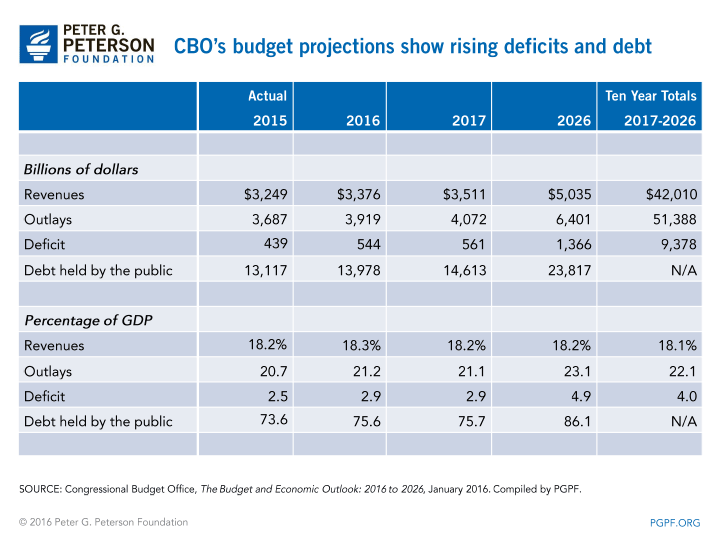
Federal debt reaches historically high levels
CBO projects that federal debt will reach 86.1 percent of GDP in 2026, which is historically very high. Since 1790, there have been only 4 years in which the debt was greater than 85 percent of GDP, and those were during and just after World War II. Beginning in 1947, debt began to fall sharply as a share of GDP, as the United States reduced its spending after the war, and the economy grew. Today, the budget outlook is much more dangerous because the projections show dramatic and sustained increases in deficits and debt due to growing entitlement and interest spending, combined with inadequate revenues.
Interest costs are projected to climb significantly from growing debts and rising interest rates
As debt continues to accumulate and interest rates increase, net interest costs on the debt are projected to more than triple over the decade, soaring from $255 billion in 2016 to $830 billion in 2026. Over 10 years, net interest costs total $5.8 trillion.
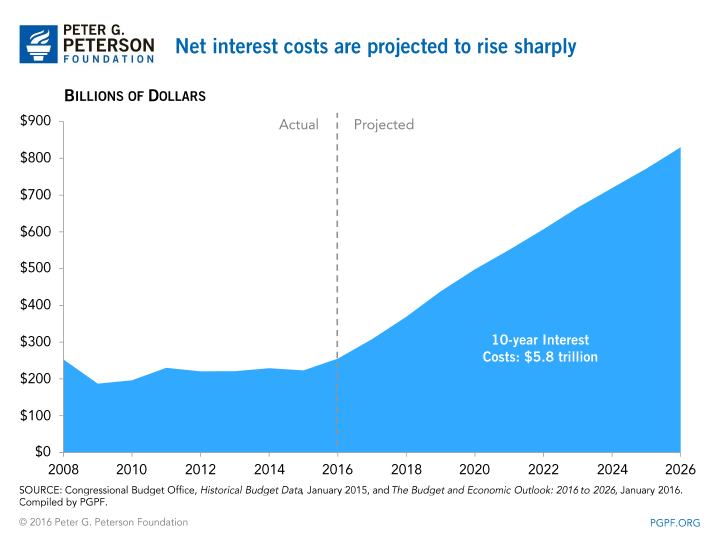
With the improved economy, the Federal Reserve has started to tighten monetary policy by raising interest rates. The Fed increased its benchmark interest rate on federal funds to 25 basis points in December 2015, after holding it near zero for 84 months. CBO forecasts that the interest rate on 3-month Treasury bills will climb from 1.1 percent in 2016 to 3.2 percent in 2026. Interest rates on 10-year Treasury notes are projected to increase from 3.1 in 2016 to 4.1 in 2026.
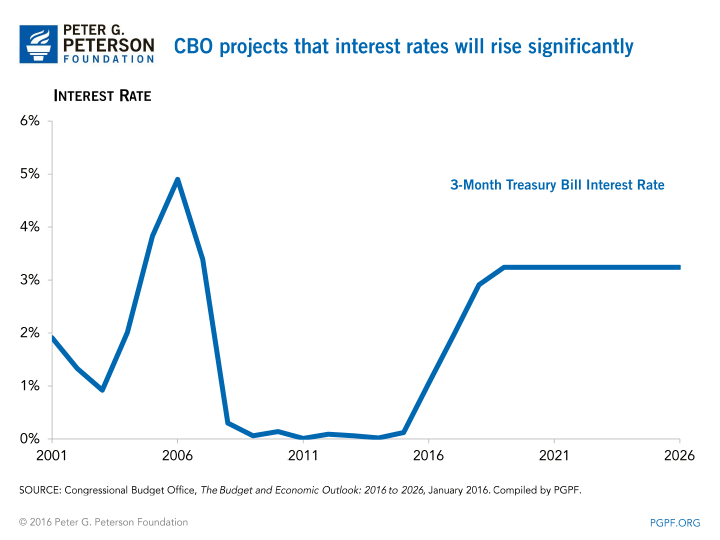
Mandatory spending is projected to climb significantly
Mandatory spending (excluding interest) is expected to increase from 13.3 percent of GDP in 2016 to 15.0 percent of GDP in 2026. This rise is attributable primarily to increased spending for major health programs and Social Security.
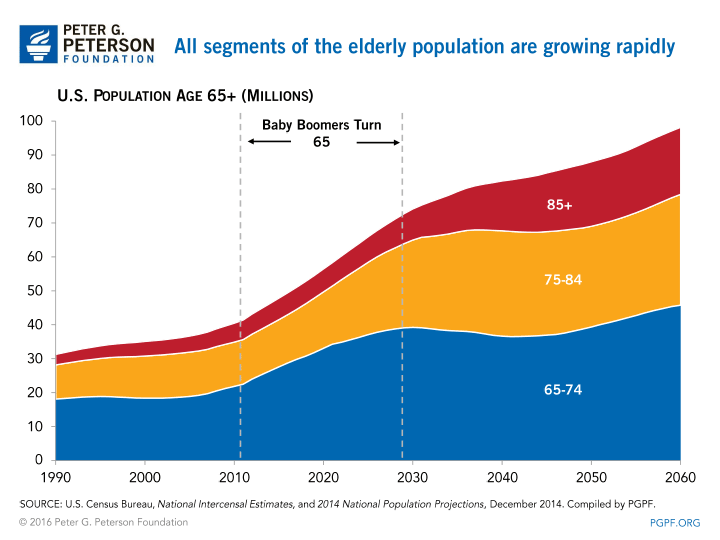
While mandatory spending and interest costs are projected to climb, federal spending devoted to discretionary programs is projected to fall to historic lows ― from 6.5 percent of GDP in 2016 to 5.2 percent of GDP in 2026. At this level, discretionary spending as a share of GDP would be nearly 30 percent below its average over the last 20 years, and lower than any year since 1962, when OMB started recording these numbers.
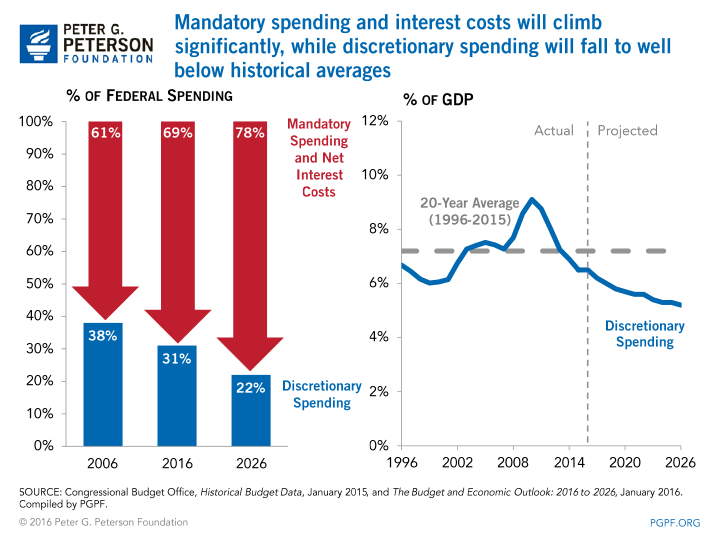
The time for policymakers to act is now
CBO’s report provides a stark warning that our nation’s fiscal outlook is unsustainable and dangerous. Even as the recovery strengthens, CBO warns that the unsustainable trajectory of our long-term debt threatens to restrain future economic growth.
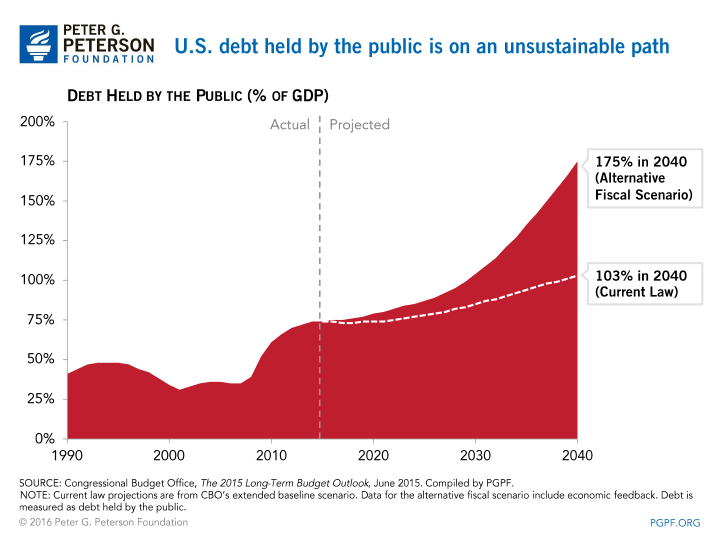
In its most recent long-term budget report, CBO estimates that within 25 years debt held by the public could climb to over 100 percent of GDP under current law and to a staggering 175 percent of GDP with less optimistic assumptions.
In recent years, many have said that the fragile nature of the recovery meant that it was not the right time to take fiscal action. However, the economy has improved considerably since the depths of the recession in 2009, as the unemployment rate has declined from 10 percent in October 2009 to 5.0 percent in December 2015. Looking forward, CBO projects that the unemployment rate will remain at levels similar to the current rate.
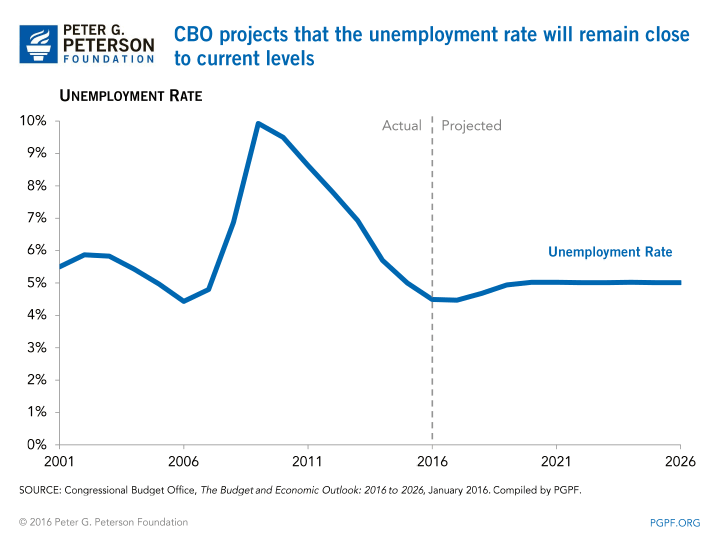
Now that the economy is stronger, we have the opportunity to put in place sensible reforms that will put our long-term fiscal trajectory on a sustainable path. The 2016 election season represents an important opportunity for a conversation between voters and candidates about America's fiscal and economic future.
